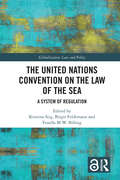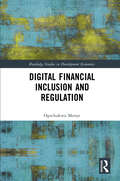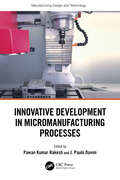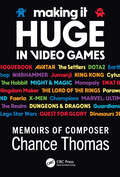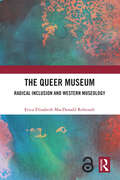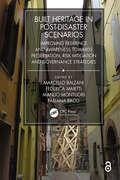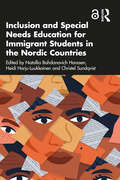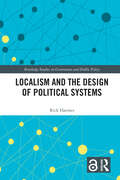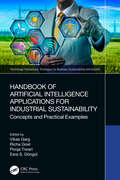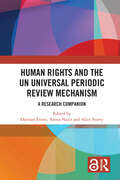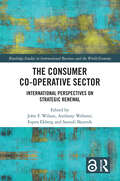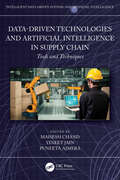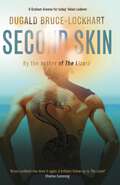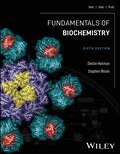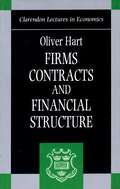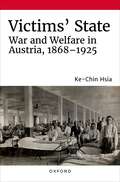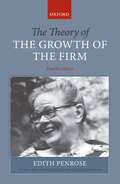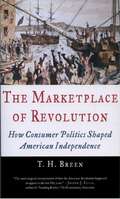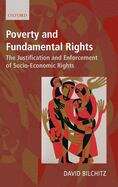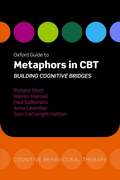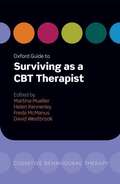- Table View
- List View
The United Nations Convention on the Law of the Sea: A System of Regulation (Globalization: Law and Policy)
by Kristina Siig Birgit Feldtmann Fenella M.W. BillingThe 1982 United Nations Convention on the Law of the Sea (UNCLOS) has for four decades been considered by many to be one of the most important legislative achievements of international law. It is revered as a "constitution of the oceans", providing the legal framework for the governance of the oceans. This volume explores how the UNCLOS is functioning in various complex settings, how it adapts to new, emerging developments, as well as how it interacts with other regulation, both within the law of the sea regime and outside. Engaging in themes such as law and order at sea, UNCLOS’ interaction with human rights and the role of private actors, the book raises complex questions in the application, understanding, and enforcement of the convention and how it can be envisaged, interpreted, and used in a dynamic world. The volume also raises methodological questions, the answers to which may enhance the predictability and coherence of the law under UNCLOS and thus secure its role as the predominant and relevant system for legal governance at sea for many decades to come.As a contribution to ensuring the future relevance of UNCLOS, the book will be a valuable resource for scholars, diplomats, judges and other practitioners who are working with and interpreting the law of the sea and related issues of maritime law, migration law, human rights law and humanitarian law.
Digital Financial Inclusion and Regulation (Routledge Studies in Development Economics)
by Ogochukwu MonyeThis book explores the various considerations for achieving an effective regulatory strategy to improve financial access and usage in Nigeria and beyond. Gaps in the legal and institutional framework for digital financial services (DFS) as well as the barriers that contribute to financial exclusion are identified as are the policy changes needed to provide more extensive, accessible and sustainable financial inclusion value. In addition, the book covers divergent themes around the use of and insights for regulating industry financial services providers and challenger entities that herald industry disruption. The book adopts three research methods. The doctrinal research method is used to buttress the law and development analysis and the themes around regulation, adoption and usage of financial services. To elucidate the application of financial innovations, comparative case studies are drawn from selected jurisdictions including Kenya, South Africa, Ghana, The Philippines, Brazil, Mexico, Uganda, Pakistan, India, and Bangladesh. Lastly, using the empirical research method, the author reports the burden experienced by the residents of a community without banks in accessing finance. Included in this discussion are the barriers to finance as well as the coping strategies adopted by the community residents to access formal and informal finance.
Innovative Development in Micromanufacturing Processes (Manufacturing Design and Technology)
by Pawan Kumar Rakesh J. Paulo DavimInnovative Development in Micromanufacturing Processes details cutting edge technologies in micromanufacturing processes, an industry which has undergone a technological transformation in the past decade. Enabling engineers to create high performance, low cost, and long-lasting products, this book is an essential companion to all those working in micro and nano engineering. As products continue to get smaller and smaller, the field of micromanufacturing has gained an international audience. This book looks at both approaches of micromanufacturing: top-down and bottom-up. The top-down approach includes subtractive micromanufacturing processes such as microturning, micromilling, microdrilling, laser beam micromachining, and magnetic abrasive finishing. The bottom-up approach involves additive manufacturing processes such as micro-forming, micro deep drawing, microforging, microextrusion, and microwelding. Additionally, microjoining and microhybrid manufacturing processes are discussed in detail. The book also aids engineers and students in solving common manufacturing issues such as choice of materials and testing. The book will be of interest to those working in micro and nano engineering and machining, as well as students in manufacturing engineering, materials science, and more.
Making it HUGE in Video Games: Memoirs of Composer Chance Thomas
by Chance ThomasMaking it HUGE in Video Games recounts the astonishing journey of an unassuming, middle-of-the-bell-curve young man, rising from mundane beginnings to scale the dizzying heights of artistic distinction and financial success in the worldwide video game industry.This is the story of Chance Thomas, a moderately talented musician who struggled and grew to compose original scores for some of the most well-known entertainment properties in the world. Detailed personal accounts and instructive side bars carry readers across the jagged peaks and valleys of an absolutely achievable career in video games. World-famous IP’s get personal treatment here – The Lord of the Rings, Marvel, Avatar, Dungeons & Dragons, Warhammer, DOTA 2, King Kong, The Settlers, and many more.Readers will discover unvarnished true stories about starting out, pitching and pursuing gigs, negotiating contracts, composing and producing scores, multinational corporations and personalities, funny anecdotes, daunting challenges, glorious successes, and instructive failures. Autobiographical details throughout provide intimate perspective, vibrant color, and inspiration. The book is written in a comfortable, conversational style.Think of this as a career guidebook wrapped around a personal retrospective; a professional how-to manual woven into a memoir.
The Queer Museum: Radical Inclusion and Western Museology
by Erica RobenaltThe Queer Museum examines how relationships between institutions and LGBTQ+ communities function and how they help to define queer museum practice.Analysing what it means to queer the museum in Western contexts, the book builds upon and challenges texts about inclusionary, activist museum practice and discusses the ways in which Othered communities are engaged with and represented. Arguing that an institution’s understanding of queerness is directly related to the kind, and extent, of change pursued by the museum, the author clarifies that governance structures, staff hierarchies, funding and relationships to queer communities affect the way queering might be pursued. The analysis looks critically at exhibitions and institutions and particularly forefronts the experiences of museum practitioners. It argues that practical changes that positively affect museums’ long-term relationships with marginalised communities are critical. The book also considers the future of the museum by drawing on queer theories of utopia, futurity, failure and amateurism to complicate understandings of the queer museum and its relationship to people and objects.The Queer Museum will be of interest to students and academics in museum and heritage studies, art history and archival studies. It will also be essential reading for museum and arts sector practitioners who seek to do and engage with this kind of work.
Built Heritage in post-Disaster Scenarios: Improving Resilience and Awareness Towards Preservation, Risk Mitigation and Governance Strategies
by Marcello BalzaniIt is assumed that the impact of natural and man-made hazards on society in terms of damage cannot be avoided. To reduce potential disaster levels and to assess which policies have had a positive outcome, a careful comparison should take place on the procedures implemented in the management of crises.The experiences with the earthquakes in the Pianura Padana area and central regions of Italy in the last ten years have been incorporated in the 'After the Damages' advanced training project. This project aims to showcase recent innovations and advancements in post-disaster management, so as to take a more proactive role in post-disaster management, and to respond more effectively when disasters occur.This volume provides insights into the dynamics and negative effects of natural and man-made hazards (i.e., earthquakes, fires, floods, droughts, volcanic eruptions, etc.), including more updated approaches to deal with post-disaster phases. The book also offers tools to deal with possible international crisis scenarios and mitigate the social impact of vulnerabilities through risk reduction.Built Heritage in post-Disaster Scenarios aims at public administration managers, government agency representatives, international organizations, researchers, and professionals in architecture, engineering, and earth science.Marcello Balzani, Architect, PhD in "Representation and Survey", Full Professor of Representation at the Department of Architecture, University of Ferrara. President of Clust-ER Building and Construction. He is author of more than 200 publications on the themes of Drawing and Architectural and Urban Surveying, Project Representation, Management and Visualisation.Federica Maietti, Architect, PhD, Associate Professor in the Scientific Sector ICAR/17 at the Department of Architecture, University of Ferrara. Member of the DIAPReM Centre, since 2005 she carries out research activities in the fields of heritage documentation, survey and diagnostic investigations, in different national and international contexts, including Pompeii, Malta, Brazil, India, and Mexico. Scientific Manager of the International Academy "After the Damages", she is involved in several research activities and she is the author of more than two hundred publications in the field of Heritage Documentation, Survey and Representation.Manlio Montuori, Architect, PhD, former assistant professor non-tenured at the University of Ferrara, Department of Architecture, where he is a member of the Labo.R.A. The main field of his research is the conservation of architectural heritage and landscape, with special emphasis on preservation procedures for traditional and industrial built heritage. His research interests also address assessment and management in the context of damage and disaster risk reduction. Scientific Manager of the International Academy "After the Damages", he is involved in several research projects implementing ICT technologies in the conservation and structural health assessment of built and cultural heritage.Fabiana Raco, Architect, PhD RTDa Researcher of Drawing at the Department of Architecture, University of Ferrara. Technical coordinator of TekneHub Laboratory. Author of more than 50 publications on the topics of Drawing, Architectural and Urban Surveying, Representation, Diagnostics, Visualization and Project Management of interventions on built heritage.
Inclusion and Special Needs Education for Immigrant Students in the Nordic Countries
by Natallia Bahdanovich Hanssen Heidi Harju-Luukkainen Christel SundqvistInclusion for immigrant students with special educational needs (SEN) is a neglected area of research. This edited volume addresses this problem, providing up-to-date insights into the provided support and special needs education (SNE) for immigrant students in different contexts of the Nordic countries.This important book explores the diversity of student experiences, addressing both compulsory schools and vocational education, and examines how different Nordic countries conceptualise and approach support and SNE for immigrant students. Readers will get an opportunity to read various studies that address gaps in the realisation of inclusion and special need education. This book initiates a dialogue on generating new knowledge, approaches, and methods to expand the flexibility necessary to implement a fully inclusive education. The book offers research that includes strong theoretical and practical frameworks, interviews, interventions, assessments, case studies as well as offers future directions for inclusive and special needs education.By exploring the process of inclusion and special needs education in the Nordic countries, this book is an essential read for those who intend to deepen their understanding and to enact inclusion, and the development of special needs education for immigrant students.
Localism and the Design of Political Systems (Routledge Studies in Governance and Public Policy)
by Rick HarmesThis book examines localism as a political idea and policy approach and explains what localism is about, why it is growing in importance and how it relates to other themes in politics.Illustrated with case studies from the United Kingdom, mainland Europe and the Indian sub-continent, the book analyses localism in conceptual and theoretical terms and locates it within the overall landscape of political thought. Key themes covered in the book include place, space and scale; decentralization and devolution; multi-level governance; public value; democracy and empowerment; and political design. With the focus on the bottom-up, constructivist aspects of localism, the book argues that localism is most likely to work successfully in a political order where sovereignty is ‘distributed’ across various social spheres and levels of government. It offers a comprehensive view of localism by synthesizing its various strands and creating a distinctive framework for design and evaluation.This book will be of particular interest to scholars, students and practitioners of localism, particularly within local and regional government, public administration and policy, human and political geography, and urban studies.The Open Access version of this book, available at www.taylorfrancis.com, has been made available under a Creative Commons Attribution-Non Commercial-No Derivatives (CC-BY-NC-ND) 4.0 license.
Handbook of Artificial Intelligence Applications for Industrial Sustainability: Concepts and Practical Examples (Technology Innovations)
by Vikas Garg Richa Goel Pooja Tiwari Esra S. DöngülThe subject of Artificial Intelligence (AI) is continuing on its journey of affecting each and every individual and will keep on this path in the times to come. This handbook is a collection of topics on the application of artificial intelligence applications for sustainability in different areas. It provides an insight into the various uses of concepts and practical examples for different domains all in one place, which makes it unique and important for the potential reader.Handbook of Artificial Intelligence Applications for Industrial Sustainability: Concepts and Practical Examples examines the influence of AI and how it can be used in several industries to improve corporate performance, reduce security concerns, improve customer experience, and ultimately generate value for customers and maximize profits. The handbook offers practical examples, concepts, and applications that provide an easy understanding and implementation process. It provides AI applications in many fields, such as sustainable credit decisions, cyber security and fraud prevention, warehouse management, and much more.This handbook will provide insight to customers, managers, professionals, engineers, researchers, and students on the various uses of AI and sustainability in different domains. All of this needed information compiled into one handbook makes it unique and important for the engineering, business, and computer science communities.
Human Rights and the UN Universal Periodic Review Mechanism: A Research Companion
by Damian Etone Amna Nazir Alice StoreyThe Universal Periodic Review (UPR) is a peer-review mechanism, reviewing all 193 UN Member States’ protection and promotion of human rights. After ten years of the existence of the UPR mechanism, this collection examines the effectiveness of the UPR, theoretical and conceptual debates about its modus operandi, and the lessons that can be drawn across different regions/states to identify possible improvements.The book argues that despite its limitations, the UPR mechanism with its inclusive, cooperative, and collaborative framework, is an important human rights mechanism with the potential to evolve over time into an effective cooperative tool for monitoring human rights implementation. Divided into three parts, the first part focuses on exploring a variety of theoretical approaches to understanding the UPR mechanism. The second part examines specific human rights themes and the relationship between the UPR mechanism and other international mechanisms. Finally, the third part questions implementation and the ways in which states/regional groupings have engaged with the UPR mechanism and what lessons can be learned for the future.The volume will be a valuable resource for researchers, academics, and policymakers working in the area of international human rights law, international organizations, and international relations. We would like to acknowledge the UPR Academic Network (UPRAN) for bringing together the experts on this project and the University of Stirling for providing funds to facilitate open access dissemination for parts of this output.
The Consumer Co-operative Sector: International Perspectives on Strategic Renewal (Routledge Studies in International Business and the World Economy)
by John F. Wilson Anthony Webster Espen Ekberg Samuli SkurnikGlobally, consumer co-operation has experienced a difficult period since the 1970s. Large scale failures in France, Germany and Austria were accompanied by loss of market share in the UK (including the failure of the Scottish Co-operative Wholesale Society and its takeover by its English counterpart). Even in the Nordic countries, where consumer co-operation has always been more robust, new challenges from the non-co-operative sector had to be confronted. How did co-operative organizations in different countries cope with these challenges? What were the processes of strategic renewal that they undertook? How successful were they? These are the key questions that the collection will address, culminating in an analysis by the editors of the effectiveness of strategic renewal in the co-operative sector. This book is a study of strategic renewal in the consumer co-operative sector, using eleven international case-studies to demonstrate how the concept has been applied over the last fifty years.
Data-Driven Technologies and Artificial Intelligence in Supply Chain: Tools and Techniques (Intelligent Data-Driven Systems and Artificial Intelligence)
by Mahesh Chand Vineet Jain Puneeta AjmeraThis book highlights the importance of data-driven technologies and artificial intelligence in supply chain management. It covers important concepts such as enabling technologies in Industry 4.0, the impact of artificial intelligence, and data-driven technologies in lean manufacturing. "Provides solutions to solve complex supply chain management issues using artificial intelligence and data-driven technologies" Emphasizes the impact of a data-driven supply chain on quality management "Discusses applications of artificial intelligence, and data-driven technologies in the service industry, and lean manufacturing" Highlights the barriers to implementing artificial intelligence in small and medium enterprises Presents a better understanding of different risks such as procurement risks, process risks, demand risks, transportation risks, and operational risks The book comprehensively discusses the applications of artificial intelligence and data-driven technologies in supply chain management for diverse fields such as service industries, manufacturing industries, and healthcare. It further covers the impact of artificial intelligence and data-driven technologies in managing the FMGC supply chain. It will be a valuable resource for senior undergraduate, graduate students, and academic researchers in diverse fields including electrical engineering, electronics and communications engineering, industrial engineering, manufacturing engineering, production engineering, and computer engineering.
Second Skin
by Dugald Bruce-Lockhart1994, five years after a murderous encounter on the island of Paros, Alastair Haston's world is upended by a startling discovery: a son he never knew existed. Desperate to learn more, he travels to Athens, but his pursuit is intercepted when MI6 intervenes, coercing him into a high-stakes espionage mission – to infiltrate a suspected mafia operation intent on abducting his son. As the chase unravels across the Mediterranean, from Athens to Zakynthos and on to Crete, Alistair has a chilling revelation, could the spectre of his past be returning to taunt him? Does the answer lie in that fateful, deadly summer on Paros five years ago?
Ellen, Countess of Castle Howel (Welsh Women's Classics)
by Anna Maria BennettThe first republication of this bestselling, influential novel since 1794, responding to Bennett's rising profile.Marked by the sometimes scandalous life experiences of its author, Ellen, Countess of Castle Howel (1794) is an insightful, often humorous look at Wales, and Britain, at a time of changing social norms and attitudes. Raised in relative seclusion in Wales, where she is preyed on by a corrupt English lord, Ellen marries Lord Castle Howel, a wealthy, older man, in order to save her grandparents' ancient estate.Transplanted to London, accompanied by her indefatigable Welsh maid, Winifred, Ellen's innocence about the workings of fashionable society brings about a separation from her husband and the loss of her reputation. Following a dash to the north of England, where she gives birth to her son, she is reunited with her husband and her good name is restored.When Lord Castle Howel is killed in a riding accident, Ellen returns to Wales and sees her and her family's fortunes transformed.An informative introduction contextualizes Anna Maria Bennett's life and writings.A seminal, insightful, witty example of the Wales-related novels which were ragingly popular in the Romantic period.A humorous and dramatic lens on a changing Welsh and British society.
Fundamentals of Biochemistry: Life At The Molecularlevel 3rd Edition Volume 2 For University Of Colorado Boulder With Wileyplus Set
by null Destin Heilman null Stephen Woski null Donald Voet null Judith G. Voet null Charlotte W. PrattFundamentals of Biochemistry, 6th Edition, with new author team Destin Heilman and Stephen Woski, is fully updated for focus, readability, and currency. This revision provides students with a solid biochemical foundation rooted in chemistry and prepares them for future scientific challenges. Its pedagogical focus remains on biochemistry's key theme: the relationship between structure/function. The text’s foundation demonstrates the relationships between the monomeric units (amino acids, monosaccharides, nucleotides, and fatty acids) and the biomolecular structures they form. The new authors continue the trusted pedagogy of the previous five editions and present approachable, balanced coverage relevant to human health and disease. Fundamentals of Biochemistry 6e includes new, stunning, and enhanced visuals and new measurable learning objectives in each chapter section that offer a practical pathway for student learning and understanding.
Firms, Contracts, and Financial Structure (Clarendon Lectures in Economics)
by Oliver HartThis book provides a framework for thinking about economic instiutions such as firms. The basic idea is that institutions arise in situations where people write incomplete contracts and where the allocation of power or control is therefore important. Power and control are not standard concepts in economic theory. The book begins by pointing out that traditional approaches cannot explain on the one hand why all transactions do not take place in one huge firm and on the other hand why firms matter at all. An incomplete contracting or property rights approach is then developed. It is argued that this approach can throw light on the boundaries of firms and on the meaning of asset ownership. In the remainder of the book, incomplete contacting ideas are applied to understand firms' financial decisions, in particular, the nature of debt and equity (why equity has votes and creditors have foreclosure rights); the capital structure decisions of public companies; optimal bankruptcy procedure; and the allocation of voting rights across a company's shares. The book is written in a fairly non-technical style and includes many examples. It is aimed at advanced undergraduate and graduate students, academic and business economists, and lawyers as well as those with an interest in corporate finance, privatization and regulation, and transitional issues in Eastern Europe, the former Soviet Union, and China. Little background knowledge is required, since the concepts are developed as the book progresses and the existing literature is fully reviewed.
Victims' State: War and Welfare in Austria, 1868-1925
by Ke-Chin HsiaThe belligerent country that literally started the First World War, the Habsburg Empire suffered grievously during the global conflict. At the end of the war, it was estimated that 1.2 million soldiers, out of 8 million men and 100,000 women mobilized from an empire of 52 million, perished in service. Among those who lived, the wounded, the disabled, and their dependents constituted at least several million people whose survival was endangered both during and after the war. How did the Habsburg Empire confront the scale of the casualties brought about by the First World War? What care and support were offered to disabled soldiers and dead soldiers' surviving dependents? Victims' State offers the first integrated account of how the Austrian half of the empire and the successor Austrian Republic responded to the needs of citizen-soldiers and their families from the nineteenth century to the interwar years. Ke-Chin Hsia traces the policies, ideas, and administrative practices developed over the decades by a range of government, semi-public, and societal actors to deal with the massive losses of lives, health, and livelihoods. The provision of care and welfare to disabled veterans, war widows, and war orphans shows that compulsory military service and war mobilization profoundly changed the relations between citizens and the Austrian state. The expansion of the Austrian welfare state was consciously undertaken by the Habsburg authorities as well as the successor Austrian Republic to generate support and create legitimacy in times of crisis. In the process, assertive war victims helped create a participatory welfare system and contributed to the democratic transition of 1918-1920. With its incisive analysis, Victims' State underscores the centrality of totalizing war to the making of modern citizenship and the fully-fledged European welfare state.
The Theory of the Growth of the Firm
by Edith PenroseThere are not many books that are genuine classics, and only a handful in business and management whose insights and ideas last for 50 years and more. This book is one of the very few 'must reads' for anybody seriously interested in the role of management within the firm. Originally published in 1959, The Theory of the Growth of the Firm has illuminated and inspired thinking in strategy, entrepreneurship, knowledge creation, and innovation. Edith Penrose's tightly-argued classic laid the foundations for the resource based view of the firm, now the dominant framework in business strategy. She analyses managerial activities and decisions, organizational routines, and also the factors that inevitably limit a firm's growth prospects. For this new anniversary edition, Christos Pitelis has written a new introduction which both tells the story of Penrose's extraordinary life, and provides a balanced assessment of her key ideas and their continuing relevance and freshness.
Firms, Contracts, and Financial Structure (Clarendon Lectures in Economics)
by Oliver HartThis book provides a framework for thinking about economic instiutions such as firms. The basic idea is that institutions arise in situations where people write incomplete contracts and where the allocation of power or control is therefore important. Power and control are not standard concepts in economic theory. The book begins by pointing out that traditional approaches cannot explain on the one hand why all transactions do not take place in one huge firm and on the other hand why firms matter at all. An incomplete contracting or property rights approach is then developed. It is argued that this approach can throw light on the boundaries of firms and on the meaning of asset ownership. In the remainder of the book, incomplete contacting ideas are applied to understand firms' financial decisions, in particular, the nature of debt and equity (why equity has votes and creditors have foreclosure rights); the capital structure decisions of public companies; optimal bankruptcy procedure; and the allocation of voting rights across a company's shares. The book is written in a fairly non-technical style and includes many examples. It is aimed at advanced undergraduate and graduate students, academic and business economists, and lawyers as well as those with an interest in corporate finance, privatization and regulation, and transitional issues in Eastern Europe, the former Soviet Union, and China. Little background knowledge is required, since the concepts are developed as the book progresses and the existing literature is fully reviewed.
The Marketplace of Revolution: How Consumer Politics Shaped American Independence
by T. H. BreenThe Marketplace of Revolution offers a boldly innovative interpretation of the mobilization of ordinary Americans on the eve of independence. Breen explores how colonists who came from very different ethnic and religious backgrounds managed to overcome difference and create a common cause capable of galvanizing resistance. In a richly interdisciplinary narrative that weaves insights into a changing material culture with analysis of popular political protests, Breen shows how virtual strangers managed to communicate a sense of trust that effectively united men and women long before they had established a nation of their own. The Marketplace of Revolution argues that the colonists' shared experience as consumers in a new imperial economy afforded them the cultural resources that they needed to develop a radical strategy of political protest--the consumer boycott. Never before had a mass political movement organized itself around disruption of the marketplace. As Breen demonstrates, often through anecdotes about obscure Americans, communal rituals of shared sacrifice provided an effective means to educate and energize a dispersed populace. The boycott movement--the signature of American resistance--invited colonists traditionally excluded from formal political processes to voice their opinions about liberty and rights within a revolutionary marketplace, an open, raucous public forum that defined itself around subscription lists passed door-to-door, voluntary associations, street protests, destruction of imported British goods, and incendiary newspaper exchanges. Within these exchanges was born a new form of politics in which ordinary man and women--precisely the people most often overlooked in traditional accounts of revolution--experienced an exhilarating surge of empowerment. Breen recreates an "empire of goods" that transformed everyday life during the mid-eighteenth century. Imported manufactured items flooded into the homes of colonists from New Hampshire to Georgia. The Marketplace of Revolution explains how at a moment of political crisis Americans gave political meaning to the pursuit of happiness and learned how to make goods speak to power.
Timpani Tone and the Interpretation of Baroque and Classical Music
by Steven L. SchweizerTimpani Tone and the Interpretation of Baroque and Classical Music explores the nature, production, and evolution of timpani tone and provides insights into how to interpret the music of J. S. Bach, Handel, Haydn, and Mozart. In drawing on 31 years of experience, Steven L. Schweizer focuses on the components of timpani tone and methods for producing it. In so doing, he discusses the importance of timpani bowl type; mallets; playing style; physical gestures; choice of drums; mallet grip; legato, marcato, and staccato strokes; playing different parts of the timpano head; and psychological openness to the music in effectively shaping and coloring timpani parts. In an acclaimed chapter on interpretation, Schweizer explores how timpanists can use knowledge of the composer's style, psychology, and musical intentions; phrasing and articulation; the musical score; and a conductor's gestures to effectively and convincingly play a part with emotional dynamism and power. The greater part of the book is devoted to the interpretation of Baroque and Classical orchestral and choral music. Meticulously drawing on original sources and authoritative scores from the seventeenth through nineteenth centuries, Schweizer convincingly demonstrates that timpanists were capable of producing a broader range of timpani tone earlier than is normally supposed. The increase in timpani size, covered timpani mallets, and thinner timpani heads increased the quality of timpani tone; therefore, today's timpanist's need not be entirely concerned with playing with very articulate sticks. In exhaustive sections on Bach, Handel, Haydn, and Mozart, Schweizer takes the reader on an odyssey through the interpretation of their symphonic and choral music. Relying on Baroque and Classical performance practices, timpani notation, the composer's musical style, and definitive scores, he interprets timpani parts from major works of these composers. Schweizer pays particular attention to timpani tone, articulation, phrasing, and dynamic contouring: elements necessary to effectively communicate their part to listeners.
Poverty And Fundamental Rights: The Justification And Enforcement Of Socio-economic Rights (pdf)
by David BilchitzThis book addresses the pressing issue of severe poverty and inequality, and questions why violations of socio-economic rights are treated with less urgency than violations of civil and political rights, such as the right to freedom of speech or to vote? Socio-economic rights have been widely regarded as aspirational goals, rhetorically useful, but having few practical implications for government policy and the distribution of resources within a polity. It is not therefore surprising that socio-economic rights have been systematically neglected in the world today, with millions still lacking access to even basic shelter, food or health care. This book seeks to provide a sustained argument for placing renewed emphasis upon socio-economic rights in the fight against desperate poverty. It utilizes a combination of political philosophy, constitutional law, and public policy in its focus on the right to food, to housing, and to health care.
Global Justice: A Cosmopolitan Account (pdf)
by Gillian BrockGillian Brock develops a viable cosmopolitan model of global justice that takes seriously the equal moral worth of persons, yet leaves scope for defensible forms of nationalism and for other legitimate identifications and affiliations people have. Brock addresses two prominent kinds of skeptic about global justice: those who doubt its feasibility and those who believe that cosmopolitanism interferes illegitimately with the defensible scope of nationalism by undermining goods of national importance, such as authentic democracy or national self-determination. The model addresses concerns about implementation in the world, showing how we can move from theory to public policy that makes progress toward global justice. It also makes clear how legitimate forms of nationalism are compatible with commitments to global justice. Global Justice is divided into three central parts. In the first, Brock defends a cosmopolitan model of global justice. In the second, which is largely concerned with public policy issues, she argues that there is much we can and should do toward achieving global justice. She addresses several pressing problems, discussing both theoretical and public policy issues involved with each. These include tackling global poverty, taxation reform, protection of basic liberties, humanitarian intervention, immigration, and problems associated with global economic arrangements. In the third part, she shows how the discussion of public policy issues can usefully inform our theorizing; in particular, it assists our thinking about the place of nationalism and equality in an account of global justice.
Oxford Guide To Metaphors In Cbt: Building Cognitive Bridges (pdf) (Oxford Guides In Cognitive Behavioural Therapy Ser.)
by Richard Stott Warren Mansell Paul Salkovskis Anna Lavender Sam Cartwright-HattonThe business of cognitive therapy is to transform meanings. What better way to achieve this than through a metaphor? Metaphors straddle two different domains at once, providing a conceptual bridge from a problematic interpretation to a fresh new perspective that can cast one's experiences in a new light. Even the simplest metaphor can be used again and again with different clients, yet still achieve the desired effect. One such example is the 'broken leg' metaphor for depression. Clients with depression are understandably frustrated with their symptoms. They may often push themselves to get better or tell themselves that they should be better by now. As a therapist, it is fair to ask, would the client be so harsh and demanding on herself after getting a broken leg? A broken leg needs time to heal and you need to begin to walk on it gradually as it builds up in strength. "You can't run before you can walk" and if you try, you are likely to make it worse. For many clients this simple metaphor is enlightening, changing their view of their symptoms as a sign of their own laziness and worthlessness, to a view of them as part of an understandable illness, that while open to improvement, cannot get better over night. This book is the first to show just how metaphors can be used productively in CBT as an integral part of the treatment. It describes the use of metaphors for a wide range of problems, including anxiety and depression, and provides countless examples of metaphors that have been used by others in CBT. It brings together in one place hundreds of metaphors that experienced therapists have used to great success. It will be a valuable sourcebook for all cognitive behaviour therapists, as well as those training in CBT.
Oxford Guide To Surviving As A Cbt Therapist: (pdf)
by Helen Kennerley Freda McManus David Westbrook Martina MuellerFor the newly trained Cognitive Behavioural Therapist, there are a wealth of challenges and difficulties faced, as they try and apply their new found skills in the outside world. These might include the stresses of working in isolation, and finding it difficult to widen their scope or bounce ideas of other C.B.T. therapists; or the need for practical advice on setting up group therapy; the possible conflicts betweens ethical practice and theory; how to retain ones integrity as a therapist, while maintaining a viable business practice; dealing with diverse communities, or becoming a supervisor. The Oxford Guide to Surviving C.B.T. Practice is the one-stop resource for the newly trained therapist. It offers practical guidance on a range of issues and challenges faced by the therapist. Written by people with vast experience of training and practising C.B.T., it draws on real life situations to help the reader hone and develop their skills, adjust to life as a therapist, and maintain a successful and satisfying career whilst helping others. With thousands of new C.B.T. therapists being trained over the coming years, this book will be a constant companion for all those starting life as a therapist, one they will want to have to hand at all times.
